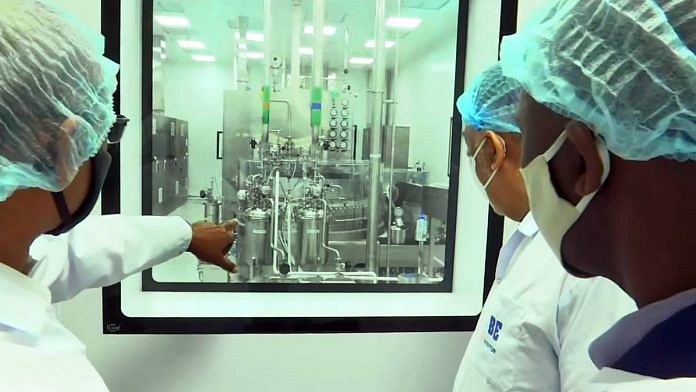Thank you dear subscribers, we are overwhelmed with your response.
Your Turn is a unique section from ThePrint featuring points of view from its subscribers. If you are a subscriber, have a point of view, please send it to us. If not, do subscribe here: https://theprint.in/subscribe/
The Race
Yuval Noah Harari has argued that the merger of biotech and infotech will define this century—a view increasingly reflected in today’s technological landscape. As nations become more interconnected, their race for dominance extends into biotechnology.
What BioTech Offers?
Advancements in healthcare, food security, agriculture, and environmental sustainability. India with its multiple revolutions from the Green and White Revolutions to the current Biotech revolution, has touched the lives of every Indians. But biotech isn’t a one-night wonder, being a high-risk and highly regulated field, it moves at its own pace. Ultimately, its success depends on a steady pipeline of skilled professionals—something only robust educational institutions and curricula can ensure.
The Big Question
Now, as we complete 25 years into the 21st century, a question looms not just among academicians and scientists but even students: Are our next generation of biotech/bioscience/life science graduates ready to accelerate India’s biotech sector despite a big gap in infotech knowledge? Because it is the conjugation of InfoTech with BioTech that enables faster disease diagnosis, climate-resilient crops, smart irrigation systems, and environmental surveillance.
And the answer is NOT QUITE YET. India’s fragmented academic approach is evident even at higher secondary or PUC levels, where students must choose between a core bio or computer domain and higher education hardly promotes inter-disciplinary approach to integrate dry-labs with wet-labs.
Where is India Placed in the Global Context?
Globally, the next biotech revolution is being powered by algorithms, not just antibodies. Countries like the United States, Germany, and China are integrating coding, machine learning, and big data tools into biotech education at both undergraduate and graduate levels. Students are learning Python alongside PCR, building models to simulate protein folding, and using AI to scan genomics datasets for disease markers. This synergy is producing not just job-ready graduates but also startups, patents, and global leadership in the bioeconomy.
India, unfortunately, is lagging. A comparative scan of state-level educational offerings reveals a disturbing trend. While most states run dozens of traditional B.Sc. and M.Sc. programs in biotechnology, only a handful—including Karnataka, Maharashtra, West Bengal, and Delhi—offer formal courses in bioinformatics or computational biology. Even within these, most remain theoretical with limited real-world coding experience or applied research.
Institutions like IBAB Bengaluru and IIT Delhi’s SCFBio stand out as rare exceptions. IBAB blends wet-lab biology with strong programming modules (Python, R, C++, Java) and mandates an industry-style research project. SCFBio, on the other hand, has built indigenous bioinformatics tools and facilitated spin-off startups—clear examples of application-oriented success. In contrast, most students hears about “bioinformatics” but rarely touch code or analyze datasets. Programs in many other states—especially in North-East and Central India—lack even this exposure.
Comparative lens with that of the U.S. shows top universities embed computational biology across life science degrees, creating a workforce aligned with market demand. In Europe, countries like Germany and the Netherlands have made bioinformatics a standard pillar of biotech education.
India’s Paradox
India’s situation is paradoxical: a global IT powerhouse with over 1,000 biotechnology colleges, but fewer than 10% offering truly integrated bio-IT programs—and only 2–3 delivering application-focused training. This gap has real consequences. Indian biotech graduates are underprepared for roles in computational genomics, algorithmic drug design, or precision agriculture. Startups in this space are often co-founded by engineers or data scientists, not biologists with dry lab experience. The risk is that India continues exporting coders and lab technicians, while innovation remains offshore.
Way Forward
While it’s not necessary—or even practical—for every biologist to become a programmer, it is crucial that biotech students are at least exposed to the digital dimensions of life sciences. Many pursue biology to avoid intensive mathematics or coding, and that choice should be respected. However, as biotechnology becomes increasingly data-driven, students must be aware of its growing intersections with computation. Those with interest or aptitude should have clear, well-supported pathways to specialize in bioinformatics and computational biology. For this, India must strengthen its bioinformatics infrastructure—by expanding programs, updating curricula, and investing in faculty and research. Giving students the option—not the obligation—to pursue this path is key to building a future-ready biotech workforce.
If India wants to lead in the bio-digital era, we must ensure that our educational system supports both pipettes and pipelines — wet-lab expertise and dry-lab knowledge. The future of biotechnology is increasingly computational. A strengthened bioinformatics ecosystem is no longer optional—it’s essential.
This article reflects the author’s insights and interpretations and is intended to contribute to ongoing discussions in the biotech education sector.
These pieces are being published as they have been received – they have not been edited/fact-checked by ThePrint.


